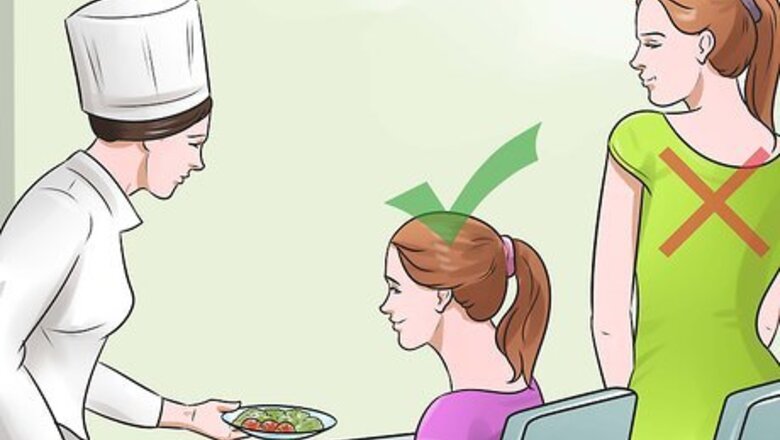
views
Practicing Basic Salad Etiquette
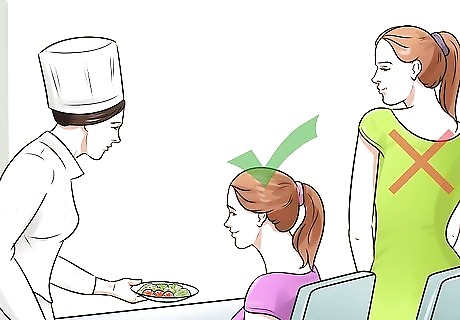
Remain still and seated when you are served. Proper dining techniques are most important in formal settings, such as when you’re having an interview or meeting, trying to impress someone, eating at a fine dining establishment, or in some other circumstance when proper etiquette is expected. In formal settings, there is often a salad course that comes either before the entrée (American style) or after the main dish (European style). The salad course in a formal meal usually consists of a basic salad, such as a green salad, wedge salad, or Caesar salad, that includes a combination of lettuce, vegetables, croutons, dressing, and possibly meat or cheese. When a server brings you your salad, do not move away or to the side when the plate is placed in front of you.

Decide if you want cheese or pepper. Someone may come around to offer you freshly grated cheese or freshly ground pepper for your salad. It is acceptable to say yes to one or both, but be sure to indicate to the server when to stop. Never add salt or pepper to your own salad (or any course) until you’ve tasted it first.

Select the proper cutlery. A place setting will be laid out with the utensils in order based on the dishes that will be served. If you are unsure which utensils are for which dish, follow this simple rule: work from the outside in. When your salad is served, use the fork and knife at the outermost edge of your place setting. They will be taken away after the salad course, and then you will move on to the next set of cutlery.
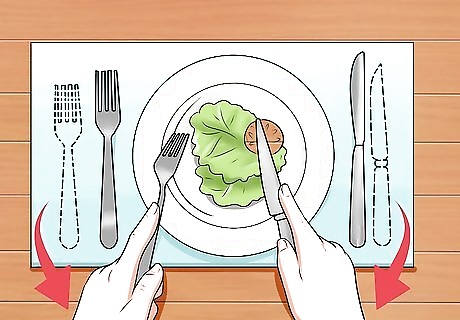
Eat your salad with a knife and fork. When the lettuce and vegetables aren’t cut up into bite-sized pieces, it is acceptable to eat your salad with a knife and fork. Alternatively, if the salad is mostly in smaller pieces, you can use your fork alone to eat. When using just your fork, you can turn it on its side and use the side of the fork to cut a piece of lettuce or vegetable into a smaller piece before eating it.

Cut and eat one bite at a time. Don’t cut up your entire salad at once; instead, eat each bite as you cut it. Make sure they are small bites, so that you don’t end up with too large a mouthful of food, or a forkful that is too large to fit into your mouth.

Don’t lean in to take a bite. When you are ready to eat, bring your fork to your mouth and gently incline your head to take the bite. Bring your fork back down immediately, and let it hover over your plate. Do the same with your knife.
Learning American Dining Practices
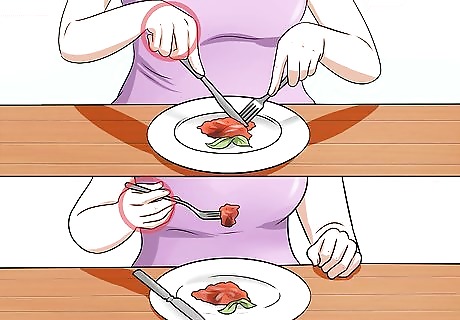
Understand American dining. In American eating style, you always perform the main cutting and eating functions with your right hand, which means you must transfer your knife and fork during the meal. To cut a bite, hold your knife in your right hand and your fork in your left hand. Hold your bite in place with the fork and cut the bite with your knife. Place your knife down on your plate, and transfer the fork to your right hand to take your bite. When you are ready for another bite, transfer the fork back to your other hand, pick up your knife, and repeat the process.
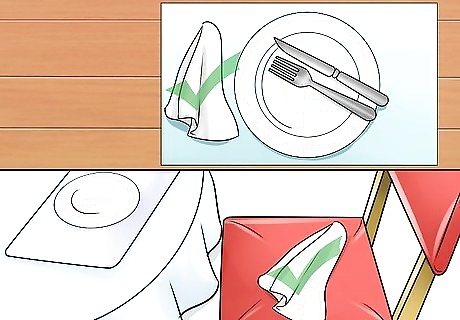
Use the silent service code with your napkin. The silent service code is a way for guests and servers to communicate without words, where guests use cutlery and napkin placement to indicate certain things throughout the meal. To indicate that you have left the table momentarily and will return to your meal, place your napkin on your chair. To say that you are finished and won’t be returning to your meal, place the napkin on the table to the left of your plate. This is true for both American and European dining.
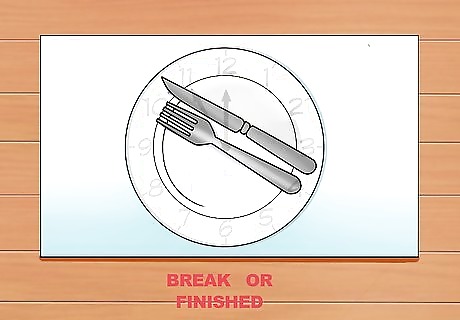
Use the silent service code with your cutlery. When you are taking a break from eating or wish to indicate you are finished with your course, place your knife and fork side by side at the 10 and 4 position on top of your plate (if your plate were a clock, the top of the knife and fork would point to 10, and the bottoms would point to the 4). Place the tines facing down if you are taking a break. Position the tines face up if you are finished. When you have finished your course, be sure to place the knife and fork on your plate, even if you didn’t used the knife designated for that course.
Learning European Dining Style
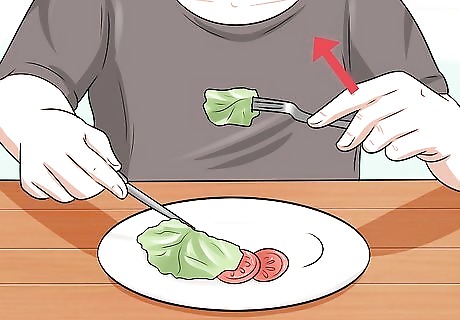
Learn the proper technique for cutting and eating. In European-style dining, you don’t transfer your fork back and forth between hands to cut and eat. Instead, you will always hold your knife in your right hand and your fork in your left throughout the meal. Use your fork to anchor your bite in place and cut it with your knife. Use your knife to gently push other pieces of salad onto your fork, such as a piece of vegetable or cheese, before taking your bite. If it’s available, use something like a crouton or bean at the end of the fork to anchor the food to the fork. When you take your bite, rest the wrist of your right hand on the edge of the table. Place your left hand in the same position after you take your bite, and leave your hands in that position until you have finished chewing and are ready to cut your next bite.
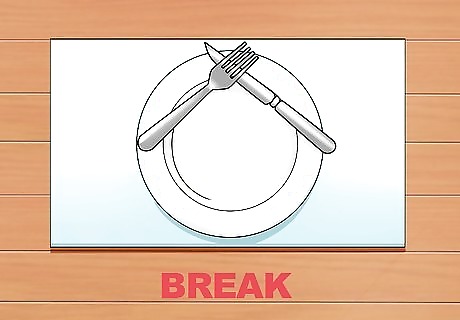
Indicate when you are taking a break. In European style, criss-cross the tips of your knife and fork across the top of your plate to indicate to the servers that you plan to continue eating, and have only taken a break to talk or drink.
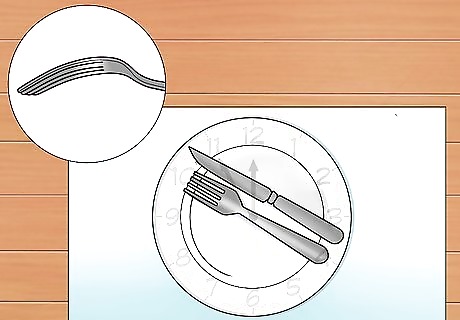
Indicate when you’re finished your course. To say you are finished with your plate in European dining, place your knife and fork side by side at the 10 and 4 position on top of your plate. Make sure the tines of the fork are facing down.
Eating Non-Traditional Salads
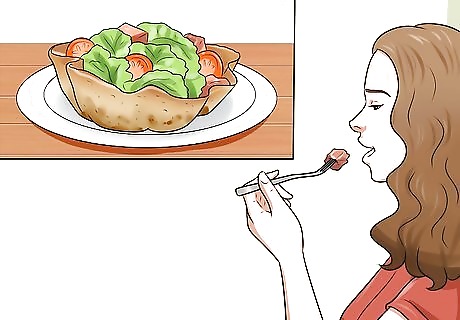
Try taco salad. Taco salad is a Mexican- or Tex-Mex-inspired dish. The salad, which is made up of lettuce, beans, corn, tomato, cheese, spices, and other taco fixings, is served with corn chips on the side, or served in an edible tortilla bowl. Taco salads are not likely to be served in a fine or formal dining setting, so you have more freedom in terms of eating them. One way to eat a taco salad is to crush up the corn chips or tortilla bowl and mix the pieces in with the salad, then eat the salad with a fork. You can also use the tortilla chips to scoop up bites of salad, and use the tortilla bites like an edible spoon.
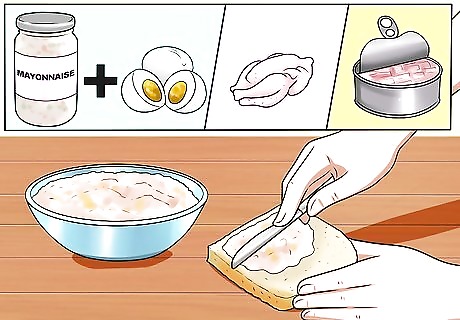
Make a salad sandwich. Tuna, egg, and chicken salads are creamy salads made with one of those ingredients and mayonnaise. They can also be mixed with other ingredients, such as spices, celery, nuts, and onions. These salads can either be eaten alone with a fork, or they can be made into a sandwich. Take two pieces of bread and either leave them plain or toast them according to your taste. Spread a thick layer of tuna, egg, or chicken salad on one piece of bread, and place the second piece of bread on top of the salad. Garnish with lettuce, tomatoes, or pickles if you like. Instead of sandwiches, these salads can also be served spread on crackers. Use a knife to spread small amounts of salad onto individual crackers.
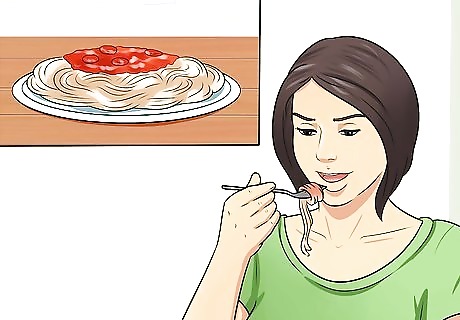
Eat potato or pasta salad. While potato salad is usually creamy like tuna or egg salad, pasta salad usually has an oil-based dressing. Both are served cold or warm, and are eaten with a fork. Potato salad is made with boiled potatoes that are cut into bite-sized pieces. It is usually mixed with mayonnaise or another cream sauce, and combined with ingredients such as onions or chives, eggs, bacon, and spices. Pasta salad uses boiled pasta, such as bowties or penne noodles, that are mixed with oil, spices, vegetables, and greens.
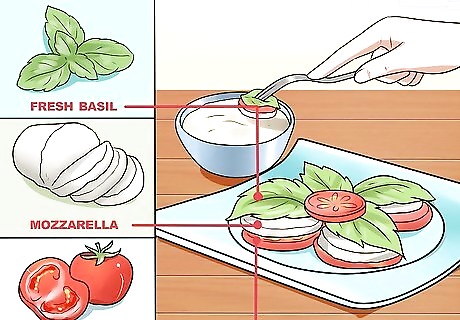
Try Caprese salad. This Italian salad is made with fresh mozzarella, raw slices of tomato, fresh basil, and a simple balsamic or olive oil dressing. The cheese and tomatoes are usually layered, and you can eat this salad with a knife and fork. Use your knife to cut off a small bite that has cheese, tomato, and basil. Dip the bite in some of the dressing before eating your bite.














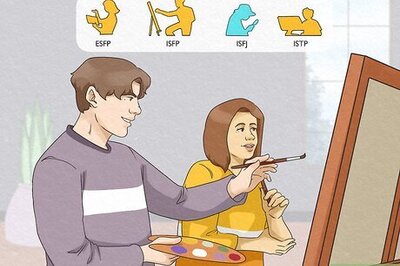




Comments
0 comment